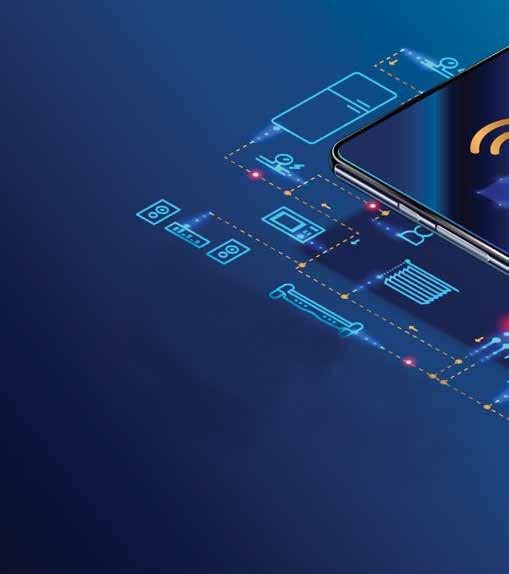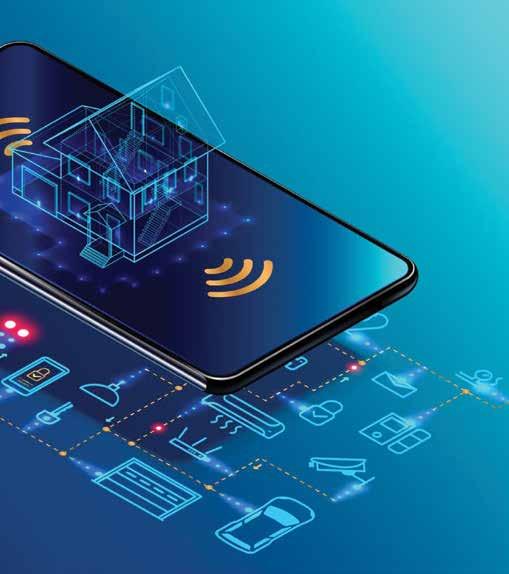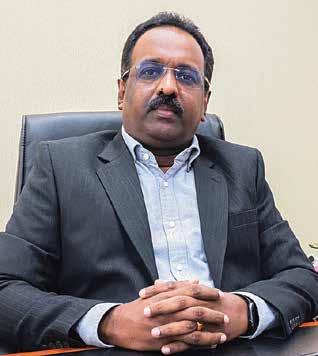
11 minute read
autom ation
Imagine walking into a door that automatically opens through a face-lock identification system. You walk in and get Alexa to play your favorite music or turn on the TV and put on your favorite channel. Further, you can also give commands to open your curtains or windows to let the fresh air come in.
The above is no longer a fictionalized account but a reality for many. Home automation has made a lot many things possible which previously seemed like a fantasy. Interior designers no longer only need to focus on basic colors, patterns, materials and layouts but also on how can they make it technology friendly for people to automate their homes the way they like.
Advertisement
“Over the years people have begun to automate many more systems” says Gopal Chandanani, Director, Cable Master Electronics LLC. “Before it was mainly lights and AC. Curtains were not very popular but have now become, along with security systems, main door intercom, audio, video, smart sockets, smoke detectors and so on.”
In-fact, in 2018, Amazon acquired Ring, a manufacturer of video doorbells in a deal valued at more than $1 billion. As Amazon already had Alexa, its virtual assistant, the brand\s control in the smart home sector increased after this acquisition signalling that the brand was now looking at entering new markets because of the growing popularity. But in UAE, are we witnessing a steep, sudden growth too?
“Home automation has been in the market for over a decade and in the UAE, it has been growing slowly and steadily,” says Luqman Hussain, Technical Manager, Expertech UAE. Gopal sec-onds Luqman saying: “It’s not that home automation did not exist before. It did, just that in Du-bai people have become more aware now and we are witnessing a rise.”
While Gopal notes that due to globalisation and thanks to the internet, a lot of customers know exactly what they want, Luqman’s main concern is that often people mistake home automation for remote automation. “The majority of homeowners believe that if they’re living in a house where they have the ability
By Diksha Vohra The upswing in Home Automat ion
Home automation in increasingly becoming popular in the UAE. But are the advantages of an internet operated home outweighing the disadvantages? SmartSMB discusses with experts.
to control their home gadgets remotely via multiple dedicated An-droid and iOS apps, means they are living in a smart home. That’s not true. What is being described here is a remote home, not a smart home.” To operate a smart home, you need to be physically there to give commands. However, remote home, an extension of smart homes, is where you can manage the activities of your house without physically being present in or around the house. The challenge is, accordingly to Luqman, communicating this basic difference to clients.
Another important challenge being faced by the home automation experts is that of price sensitivity. According to Gopal, depending on the extent of your home automation, you can be charged anything between AED 50,000 to 500,000 for one project, which is a hefty amount. If, however, customers are made more aware of the different home automation options, because not everyone may necessarily want everything to be automated, the costs associated with each and



— By Diksha Vohra
how much technical inputs and expertise are required, they’d be more appreciative of the price. Luqman says: “With the emergence of wireless technologies and DIYs, IoT device auto-mation is now in presence and can be easily deployed at most of the residence giving the sense of Home Automation.”
But a fully automated home can provide a huge sigh of relief to many people, especially for whom safety and security of their families is a priority. “By using camera locks, you can ensure safety of your family especially when your kids are home and you’re out,” says Luqman. “More-over, you can reduce your expense because automation will ensure your electrical appliances are not turned on when not in use, thereby ensuring an Improved lifestyle.”
As per Gopal, in addition to energy saving, the advantages include: “The ability to complete monitor your systems from anywhere in the world. Everything is onetouch so it saves so much time of yours, makes you more productive. Moreover, an automated home looks stylish too.”
Despite these, there are a couple of disadvantages of home automation. The first and foremost is the pricing, which even experts agree with. The second in line, as Gopal notes is: “…it re-quires additional contractors like civil and electrical contractors for the major cabling of services like lights and AC. Moreover, because the appliances are used majorly by the house helps who aren’t as tech savvy, they can mess up the entire system if not educated and monitored properly.”
Luqman also says that the implementation needs to be done by an expert. “For example, adopting the correct wireless protocol, Implementing a se-cured network, these are things you cannot absolutely compromise on.” Especially for the price conscious consumers, ensuring they are using the right experts is quite important.
Looking at the future and scope of improvement, Gopal wishes to see more development in the wireless sector. Presently, most of the things use wires and physical set up. However, wireless solutions can not only be more cost effective in the long run but also more reliable and safe. “There are many wireless solutions but they all need to improve on their wireless connectivity and longevity. Many clients are opting for wireless solutions as they save on costs of major cabling, breakage of walls etc that comes with conventional automation.”
In conclusion, however, remote automation seems the key to growth and the next big thing to look forward to. Luqman foresees an entirely different world though in the coming years. “Future Smart Homes will be intelligent to automatically adapt the home environment according to the homeowners’ comfort, Safeguarding the properties against intrusions while reducing energy consumption to help to reduce the carbon footprint. In fact, with the growth of the usage of voice assistance like Siri, Alexa, Google Assistant, Cortana and IoT devices, you will not require mobile phones to operate your Smart Home. All automation will be based on AI and Machine learning.”
THE TRANS FORMATION CATALYST
A leading SI in the region, CADD Emirates is playing the role of a catalyst in enabling successful digital transformation for its customers. Read on for more details from the spokesperson, Biju Abraham, Director - Networking & Security Solutions
As a systems integrator in the region, what makes CADD Emirates stand out? Briefly discuss the top solutions you bring to the market.
CADD Emirates is a 100% locally owned company having four offices in UAE. Having completed 25 years, CADD Emirates has played an integral part in the IT Transformation of UAE. We have always been a trusted IT advisor for our customers and have always put them first before anything. We go with our motto – “Meeting & exceeding customer expectations by providing the most innovative & comprehensive solutions and achieve their overwhelming satisfaction”. We serve more than 3000 customers every year and our customer list is growing every year. We have been a pioneer in security solutions, network & wireless infrastructure, hospitality solutions, cloud & infrastructure solutions as well as CADD & engineering solutions.
What kind of demand do you see for your products and solutions in the market? What are your key verticals to focus?
Every business today is undergoing a huge transformation digitally and continuous innovation is the key element towards success. Our products and solutions are aligned to meet these changing trends and help our customers to succeed in their digital transformation journey. We offer solutions & services in the following focus areas including but not limited to cloud, security, infrastructure and mobility.
With the EXPO 2020 scheduled to begin later this year and the fact that the UAE is a tourist hub, the hospitality sector will see growth. We have increased our focus in this sector as we have a huge portfolio of solutions & services that could be a fit across their entire ecosystem.
How are you positioning yourself amidst competition?
Biju Abraham Director Networking & Security Solutions

That is our biggest strength & sustains our credibility with our customers.
What are the opportunities for SI s in the era of digital transformation?
SIs have a crucial role to play in enabling digital transformation, from setting up secure networks to enabling data capture and deploying adaptive and intelligent systems. Something that is common in the implementation of digital transformation is the need for data. Most brownfield manufacturing plants and machines were not designed with data capturing and sharing in mind. In addition, many sites include a colorful patchwork of legacy systems — most of them proprietary in nature — further adding complexity. This is, nevertheless, the environment SIs work in daily.
The most fundamental step in digital transformation is to network the factory floor, and this is a typical area of delivery for SIs. Networking will also require appropriate cybersecurity protection, a growing area of expertise for SIs.
While connectivity likely is the first step for most, later steps deal with making this data “visible,” i.e., putting it in context. An example could be providing a machine operator with key indicators for their machine and the overall production to make better decisions. One example is when to schedule a maintenance break to deal with an issue indicated by a predictive asset monitoring software. Many additional steps can follow deploying adaptive and intelligent systems once the organization has taken care of the basics. Some of these more advanced tools provide SIs with opportunities to further specialize. Manufacturers appreciate deep industry vertical expertise in their SIs.
SIs can play an emerging role as an advisor in the early stages of digital transformation plan development and can supplement cross-functional teams with cost estimates and technology options. They also can help manufacturers determine the readiness of their human resources through Smart Industry Readiness Index audits.
Digital transformation thus creates exciting opportunities for SIs with the need for renewal of their value propositions, offers and business models. In some ways, some of these changes will help SIs address some of their own company challenges.
What are the major CIO challenges face in making the right Technology investments? How do you see digital transformation as a key driver in investment decision making?
Driving and embedding digital transformation in the company business strategy is a key responsibility for the CIO today. As part of these expectations, the CIO needs to take on a more strategic role in their company and be responsible for driving necessary digital transformation across the business. This also includes the balancing act of ensuring the systems are performing well while investing in new infrastructure and fostering innovation to help the business compete in a constantly changing business landscape.
There is the need to being responsive to internal clients as these clients rely on IT systems functioning. Being available to them around the clock, in order to ensure their jobs get done without disruption because of IT downtime, is the reality of business life in the 21st century. Industry disrupters have changed the business landscape for good across many different industries. In many instances, disrupters have caused companies to collapse. For the CIO the challenge will depend on their company’s industry: are the threats there already, or are they likely to come soon? Being placed to respond to new systems and technology required to compete with new business models within the industry is crucial. In doing this the CIO needs to be constantly eyeing the future so they can launch new projects and initiatives quickly in order to protect their company’s market share.
What sort of investments are you envisioning to make in the coming years, in order to reach out to key verticals across various markets?
Among our best practices, we are constantly liaising with Industry experts for different verticals. We focus on continuous training & updating the employees about the latest trends. We have gone ahead with digital transformation within our organization and we are always adding new products that are aligned to our business portfolio
Tell us about your partnership with HPE-Aruba
CADD Emirates has been a proud HPE-Aruba Platinum Partner in UAE for the last seven years, offering their complete portfolio of solutions to our customers in UAE. CE has the greatest number of certified and trained engineers for HPE Aruba in this region. 70% of the revenue for Networking & Security department comes from Aruba Solutions. CADD Emirates has seen year on year growth in terms of Aruba Sales and in the past severalyears, we have been at the top position as a HPE Aruba Products & Solution Seller.
We provide solutions to companies like Emirates NBD, Mashreq Bank & Dubai Islamic Bank, DP World & many other major entities. Along with that we have a contract with Etisalat for providing 3G, 4G off-loading solutions. We provide Aruba wi-fi network to malls & other public areas. We can proudly say that we are the best NAC solution provider of HPE Aruba. CADD Emirates is a 100% focused company, we believe in ‘Customer first Customer last’ & that’s the same strategy HPE Aruba also follows. Until and unless you have the right kind of relationship with the customer, you won’t grow and at the same time we have to keep the right kind of relationship with the vendor as well. One of the major education institutions of UAE, Gems Education Group is our customer and we have provided services to almost 43 schools for their complete IT infrastructure. We strongly believe that until and unless your support team is strong, we won’t be able to retain the customer. This is something that CADD Emirates has been doing successfully over the years as we strongly feel that our team is our strength.








